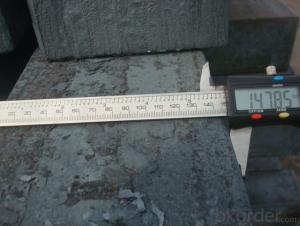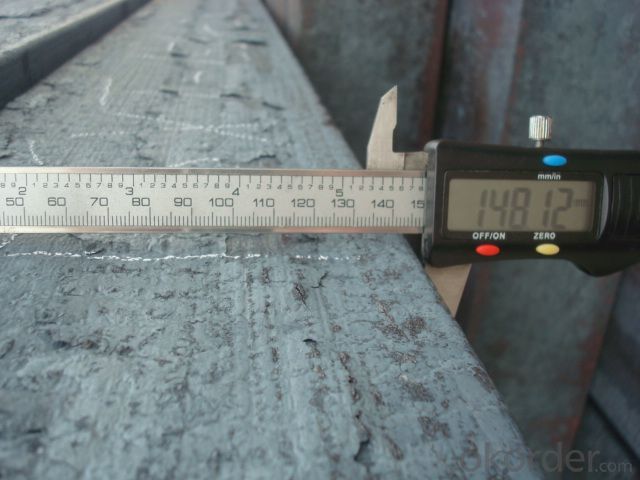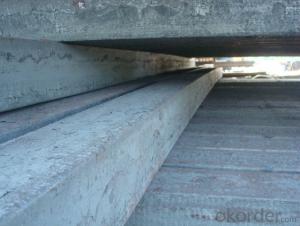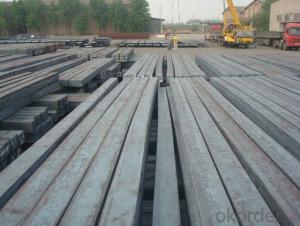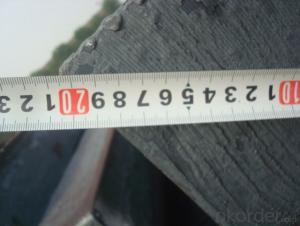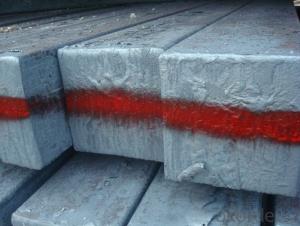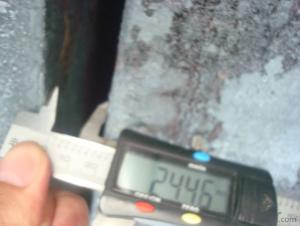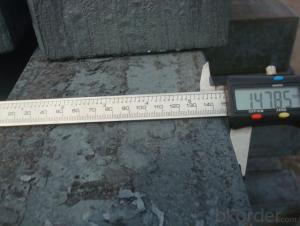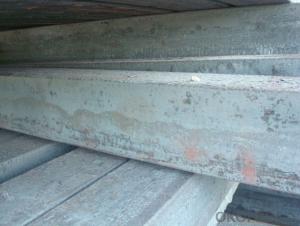Alloyed Steel Bloom/Billet Manufactured by Blast Furnace
- Loading Port:
- Tianjin
- Payment Terms:
- TT OR LC
- Min Order Qty:
- 1000 m.t.
- Supply Capability:
- 10000 m.t./month
OKorder Service Pledge
OKorder Financial Service
You Might Also Like
Alloyed Steel Bloom/Billet Manufactured by Blast Furnace
1.Structure of Alloyed Steel Bloom/Billet Manufactured by Blast Furnace
Steel Billets Manufactured by Continue Casting is the raw material of all kinds of steel mill. Billet section of square, round, flat, rectangular and abnormity, etc Several, mainly related to shape of rolled products. Simple rolled section steel, choose cross section of square billet or rectangular billet. rolling The sector products such as flat steel, Angle steel, select the rectangular billet or slab. Had better profiled billet when production beams, channels, and in rolling process Lines and improve the yield. The raw material of round billet is the production of seamless tube.
2.Main Features of Alloyed Steel Bloom/Billet Manufactured by Blast Furnace.
Steel Billets Manufactured by Continue Casting section size should meet the requirements of rolling deformation and finished product quality, but also roll strength and biting condition of restrictions. General steel Billet section height H. And the roll diameter D The ratio of the ( namely H/D) Should be less than or equal to zero 0.5 . Length of steel billet by finishing temperature, Rolling time and the length of the product Or times ruler. When heated too long accident prone to bump the furnace wall of steel, too short, furnace bottom utilization rate is not high, influence the heating furnace production. For the production Choose a variety of steel and steel billet, should consider the affinities of billet, as far as possible in order to improve the productivity of the roughing mill, simplify the stock management of workshop.
There are three shapes of the steel billets: square billet, slab, rectangular billet The Chinese billet, rectangular billet is mainly suitable for rolling hot rolled strip, building reinforced bar, Ordinary wire, high speed wire rod and various small profile. Of the slab are mainly used for rolling plate and hot coil sheet.
3. Alloyed Steel Bloom/Billet Manufactured by Blast Furnace Images
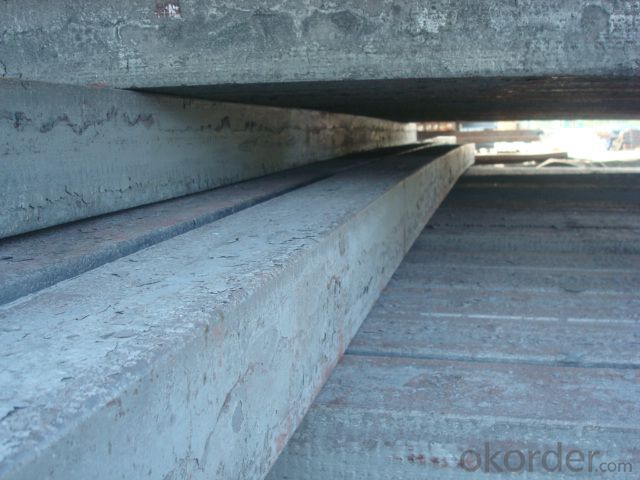
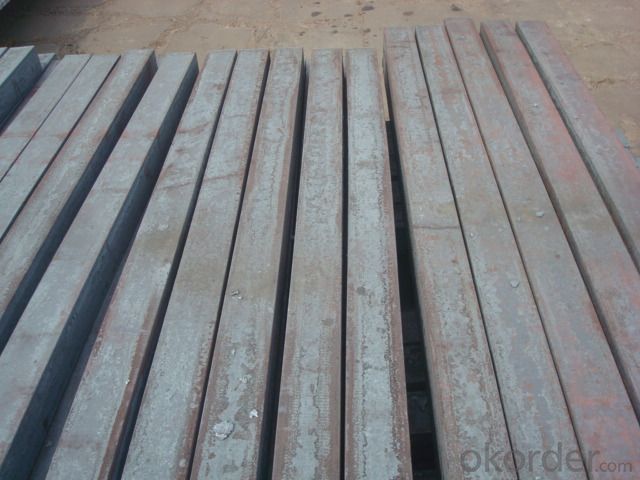
4. Alloyed Steel Bloom/Billet Manufactured by Blast Furnace Specification
Material standard The editor Range of thickness: 150-240 - mm + / - 5 mm width range: 880-1530 - mm + / - 20 mm Length: 3700-10000 - mm + / - 500 - mm Cross-sectional size: 64 * 64; 82 * 82; 98 * 98; 124 * 124; 120 * 150; 152 * 164; 152 * 170 mm Length: 9000 mm Section of tolerance: billet: 1.0 + / - 2.0-1.0 + / - 1.0 mm slab: width: + / - 2.0 mm thickness: + / - 3.0 mm The length tolerance: + / - 200 mm Section diagonal tolerance: 3.5-8.0 MM Billet section size protrusions requirements: < 1242 mm, do not allow; > = 1242 mm, < = 2 mm 1242 mm, < = 3 mm Beheading (shear) extension deformation: < 1242 mm billet: no control; The slab: < = 15 mm Surface tilt: no more than billet section 0.1 Bending: every 1 m length is not more than 10 mm The distortion: length < = 5 m, < = 11. ; The length of the < = 7.5 M, < = 5. Material % 3 sp/PS chemical composition: C Mn Si S P
5.FAQ of Alloyed Steel Bloom/Billet Manufactured by Blast Furnace
We have organized several common questions for our clients,may help you sincerely:
①How about your company?
A world class manufacturer & supplier of castings forging in carbon steel and alloy steel,is one of the large-scale professional investment casting production bases in China,consisting of both casting foundry forging and machining factory. Annually more than 8000 tons Precision casting and forging parts are exported to markets in Europe,America and Japan. OEM casting and forging service available according to customer’s requirements.
②What are the slab quality problem?
(1) of slab of purity (inclusion quantity, shape, distribution, etc.);(2) the surface of the casting defects (cracks, slag inclusion, porosity, etc.); (3) slab internal defects (cracks, segregation, inclusion, porosity and shrinkage cavity, etc.). Slab of purity depends mainly on molten steel into mold before processing, namely before pouring molten steel make "clean";Cast to the control process at the same time, don't let the inclusions with steel downward. Slab of purity control starts () electric furnace and converter smelting to refining outside the furnace, tundish metallurgy, protective casting and electromagnetic stirring process control of the whole process.
What are the types of non-metallic inclusions in continuous casting billet? The non-metallic inclusions in continuous casting billet, according to the generated methods can be divided into endogenous inclusions and exotic inclusions. Endogenous inclusions, mainly is pointed out that steel, ferroalloy products and pouring molten steel and air secondary oxidation in the process of product, such as aluminum oxide. Foreign inclusions, mainly to the inclusion of smelting and casting process, such as the erosion of ladle, tundish refractory, involved in the package of slag and protecting slag, shuikou washed residue, etc. The final solidification in continuous casting billet size, quantity and distribution of inclusions and is affected by the purity of molten steel in tundish, the impact of the mold injection flow depth and the movement state of the flow injection etc.For curved continuous caster, from intrados 1/4 thickness in inclusions have gathered phenomenon, this is a serious defect.Electromagnetic stirring can control the movement of molten steel in mould, and exclusion of inclusions, therefore we have to be serious study of the production of impurity and motion law.
③What is the advantage of the continue Casting steel billet comparing to the die casting steel billet?
Compared with die casting, continuous casting has the advantages of: 1. To simplify the Steel billet The production process 2. Improve the metal yield 3. Improve the quality of the billet 4. Reduces the steel worker's labor intensity 5. Save energy and reduce consumption
Steel billet is produced by the method of through three processes: It is through the steelmaking system of continuous casting equipment, directly by the molten steel pouring into billet; The second is the steelmaking system in the production of steel ingot casting billet through system of steel rolling rolling equipment or processing of steel semi-finished products; Three is the steelmaking system production of steel ingot by forging the semi-finished product processing equipment.
- Q: How are steel billets used in the manufacturing of slabs?
- Steel billets are used in the manufacturing of slabs by being heated and then rolled into a flat shape. The billets act as the starting material for the slab production process, undergoing various treatments and forming operations to achieve the desired dimensions and properties of the final slab.
- Q: How are steel billets used in the production of oil and gas machinery?
- The production of oil and gas machinery heavily relies on steel billets. These billets are essentially semi-finished pieces of steel that undergo further processing to produce various components needed in the oil and gas industry. To begin with, steel billets are essential in manufacturing the key structural components of oil and gas machinery, such as frames, bases, and casings. These components provide the necessary strength, stability, and support to the equipment, ensuring their safe and efficient operation even in harsh operating conditions. Furthermore, steel billets are also utilized in the production of critical rotating parts, including shafts, gears, and turbines. These components experience high loads, intense pressure, and extreme temperatures, making exceptional strength and durability a requirement. Steel billets, known for their superior mechanical properties, are an ideal material for manufacturing such parts. In addition, steel billets are employed in the production of valves, fittings, and connectors that are integral to oil and gas machinery. These components are responsible for controlling the flow of oil or gas, regulating pressure, and ensuring secure connections between various equipment and pipelines. Steel billets are chosen for these applications due to their excellent corrosion resistance, which is crucial in environments where oil and gas are present. Moreover, steel billets find application in the fabrication of heat exchangers and pressure vessels used in the oil and gas industry. Heat exchangers play a vital role in cooling or heating fluids, while pressure vessels store and transport hazardous substances safely. Steel billets are preferred for these applications due to their high thermal conductivity, excellent weldability, and resistance to extreme pressures. In summary, steel billets are extensively utilized in the production of oil and gas machinery because of their exceptional mechanical properties, corrosion resistance, and thermal conductivity. These billets provide the necessary strength, durability, and reliability to the components and equipment required in the oil and gas industry, ensuring safe and efficient operations in this critical sector.
- Q: What are the potential applications of steel billets in the chemical aftermarket?
- Steel billets have a wide range of potential applications in the chemical aftermarket. One of the key uses of steel billets is in the production of various chemical processing equipment. These billets can be used to manufacture reactors, heat exchangers, columns, and other critical components that are used in chemical plants. Furthermore, steel billets are also utilized in the construction of storage tanks for storing chemicals. These tanks need to be strong, durable, and resistant to corrosion, and steel billets provide the necessary properties to meet these requirements. In addition, steel billets find applications in the fabrication of pipelines and piping systems used for transporting chemicals. The high strength and resistance to temperature and pressure make steel billets an ideal choice for constructing pipelines that can handle corrosive and hazardous chemicals. Moreover, steel billets can be shaped and formed into various fittings and flanges that are essential components in chemical systems. These fittings and flanges are used to connect different sections of piping, valves, and other equipment, ensuring a secure and leak-free operation. Overall, the potential applications of steel billets in the chemical aftermarket are vast and diverse. From manufacturing chemical processing equipment to constructing storage tanks, pipelines, and fittings, steel billets play a crucial role in ensuring the safe and efficient operation of chemical facilities.
- Q: What are the different types of steel billet rolling mill defects?
- During the rolling process of steel billet in a rolling mill, various types of defects may occur. These defects can impact the final product's quality and performance and can have different causes. Some commonly observed defects include: 1. Surface defects: Scratches, cracks, pits, and scale are visible defects that can occur on the surface of the rolled billet. These defects can be caused by improper handling, insufficient lubrication, or excessive rolling pressures. 2. Shape defects: Deviations from the desired shape of the billet, such as bowing, twisting, or excessive tapering, are referred to as shape defects. Uneven cooling, improper alignment of the rolling mill, or incorrect rolling parameters can cause these defects. 3. Internal defects: Internal defects are not visible on the surface but can impact the structural integrity of the billet. Segregation, porosity, and inclusions are examples of internal defects. The presence of impurities in the raw material, improper heating or cooling, or inadequate quality control measures can cause these defects. 4. Dimensional defects: Deviations from the desired dimensions of the billet, such as variations in length, width, or thickness, are called dimensional defects. Improper calibration of the rolling mill, incorrect rolling parameters, or inadequate quality control measures can cause these defects. 5. Metallurgical defects: Metallurgical defects occur due to improper metallurgical processes during rolling. Grain size variations, improper grain flow, or undesirable microstructure are examples of metallurgical defects. Improper temperature control, inadequate alloying, or insufficient heat treatment can cause these defects. To ensure the production of high-quality steel billets, it is crucial for steel billet rolling mills to implement proper quality control measures. Regular inspections, testing, and monitoring during the rolling process can help identify and rectify these defects, thus minimizing their occurrence.
- Q: I want to buy a fishing pole, I don't know how to distinguish it. Know what, please reply, thank you, [em10]!
- Carbon fishing rod is divided into: carbon, pure carbon, high carbon.Carbon packaging, as the name suggests, two layers of material, the outside is a layer of carbon cloth, the inside layer is glass fiber, epoxy cloth. This kind of pole price is lower, this kind of pole does not recommend the brand, because the price is low, does not need to buy the brand. With a few times you can change, for beginners.Pure carbon refers to the overall use of 30T carbon cloth below the production of fishing rod, general 24T, 30T based, carbon content of more than 98%. The price is moderate, the fishing rod is recommended in the field of Koi, Koi a large proportion of domestic brands is unmatched, good quality.High carbon refers to the overall use of 30T carbon cloth above the fishing rod, but not the whole fishing rod is made of a carbon cloth.
- Q: How are steel billets used in the production of agricultural irrigation systems?
- Agricultural irrigation systems necessitate steel billets as a crucial element. These semi-finished steel products are utilized to fabricate diverse components of irrigation systems, including pipes, fittings, and valves. In the manufacturing of irrigation pipes, steel billets are employed as the primary material that undergoes a series of processes to shape seamless or welded pipes. The billets are heated and subsequently passed through a piercing mill, where they are further elongated and molded into a hollow tube. Following this, the tubes are stretched and rolled to attain the desired diameter and thickness. As a result, the steel pipes produced are robust, long-lasting, and resistant to corrosion, making them ideal for agricultural irrigation systems. Moreover, steel billets are employed in the production of fittings and valves for irrigation systems. By shaping and machining steel billets, fittings such as elbows, tees, and reducers are manufactured to meet specific size and shape requirements. These fittings are pivotal in connecting and directing water flow within the irrigation system. Furthermore, steel billets are occasionally used in the fabrication of pump housings and other structural components of irrigation systems. Due to their strength and stability, steel billets provide the necessary support and durability required in these applications. In conclusion, steel billets play an essential role in the production of agricultural irrigation systems. They offer a reliable and robust material for pipes, fittings, valves, and other components. Their usage ensures the longevity and efficiency of these systems, facilitating effective water distribution and irrigation in agricultural fields.
- Q: What are the different types of steel billet surface treatment defects?
- There are several types of steel billet surface treatment defects that can occur during the manufacturing process. These defects can affect the quality and appearance of the steel billets, and it is important to identify and address them to ensure the overall performance of the final product. 1. Scale: Scale is a common defect that occurs when the steel billet is exposed to high temperatures during the manufacturing process. It appears as a layer of oxide on the surface of the billet, which can affect the adhesion of coatings or paints. 2. Inclusions: Inclusions are non-metallic particles or impurities that can be present on the surface of the steel billet. These inclusions can be caused by various factors, such as inadequate cleaning or improper handling during the manufacturing process. They can negatively impact the mechanical properties of the steel and reduce its overall performance. 3. Decarburization: Decarburization is a defect that occurs when the surface layer of the steel billet loses its carbon content due to exposure to high temperatures or a lack of protective atmosphere. This can lead to reduced hardness and strength in the affected area. 4. Pitting: Pitting is a localized defect that appears as small cavities or pits on the surface of the steel billet. It can be caused by the presence of impurities or by exposure to corrosive environments. Pitting can compromise the structural integrity of the billet and make it more susceptible to corrosion. 5. Surface cracks: Cracks can occur on the surface of the steel billet due to various factors, such as thermal stress, improper handling, or inadequate cooling. Surface cracks can weaken the billet and increase the risk of failure during subsequent processing or use. 6. Surface roughness: Surface roughness refers to an uneven or irregular surface texture on the steel billet. It can be caused by factors such as improper machining, inadequate cleaning, or the presence of scale or inclusions. Surface roughness can affect the appearance of the billet and may also impact its performance in certain applications. Overall, it is crucial to identify and address these surface treatment defects to ensure the quality and reliability of steel billets. Proper manufacturing processes, including adequate cleaning, protective atmospheres, and appropriate handling, can help minimize the occurrence of these defects and ensure the optimal performance of the final product.
- Q: Can steel billets be used in the production of bicycles?
- Yes, steel billets can be used in the production of bicycles. Steel is a commonly used material in bicycle manufacturing due to its strength, durability, and affordability. Steel billets can be shaped and manipulated to form various bicycle components such as frames, forks, and handlebars.
- Q: What are the potential applications of steel billets in the transportation aftermarket?
- Steel billets offer a wide range of potential applications within the transportation aftermarket. One primary use in this industry involves using steel billets to produce various components and parts for vehicles. These billets possess the strength and durability necessary for manufacturing engine parts, suspension components, steering parts, and other critical components. Moreover, steel billets are well-suited for manufacturing structural components like chassis frames and body panels. The robustness and rigidity of steel make it an ideal material for these applications, allowing it to withstand the stresses and strains experienced during vehicle operation. Additionally, steel billets find use in producing wheels and rims for automobiles, motorcycles, and bicycles. Their exceptional strength and ability to handle heavy loads make steel billets the preferred choice for wheel manufacturing, ensuring road safety and reliability. Furthermore, steel billets can be utilized in manufacturing rail tracks and infrastructure for railways. The strength and durability of steel make it an ideal material for rail tracks, ensuring the secure and efficient transportation of goods and passengers. All in all, the applications of steel billets in the transportation aftermarket are diverse and extensive. They play a crucial role in manufacturing critical vehicle components and constructing infrastructure for railways, ultimately ensuring the efficiency, safety, and reliability of transportation systems.
- Q: How are steel billets used in the manufacturing of energy sector components?
- Steel billets are crucial in the production of various components used in the energy sector. These billets are typically created through continuous casting, a process where liquid steel is poured into a mold and solidifies into a long, rectangular shape. Within the energy sector, steel billets are the primary raw material for manufacturing a wide range of components. One common application is in the production of pipelines. These billets are heated and then rolled or forged to create seamless or welded pipes, which are used to transport oil, gas, and other fluids over long distances. The strength and durability of steel make it an excellent material for pipelines, ensuring the safe and efficient transportation of energy resources. Steel billets also play a role in the production of power generation equipment. They are shaped and machined into components such as turbine blades, shafts, and rotors, which are vital for power plant operation. Steel's exceptional mechanical properties, including high tensile strength and corrosion resistance, make it suitable for withstanding the harsh conditions and high temperatures experienced in power generation processes. Moreover, steel billets are used in the manufacturing of renewable energy infrastructure, like wind turbine towers. These billets are transformed into large cylindrical sections that provide structural support for wind turbines. The strength and stability of steel guarantee that wind turbines can withstand the forces exerted by the wind and efficiently generate electricity. In conclusion, steel billets are essential in the energy sector as they serve as raw materials for pipelines, power generation equipment, and renewable energy infrastructure. Their strength, durability, and resistance to corrosion make them ideal for enduring demanding conditions and ensuring the reliability of energy sector components.
Send your message to us
Alloyed Steel Bloom/Billet Manufactured by Blast Furnace
- Loading Port:
- Tianjin
- Payment Terms:
- TT OR LC
- Min Order Qty:
- 1000 m.t.
- Supply Capability:
- 10000 m.t./month
OKorder Service Pledge
OKorder Financial Service
Similar products
Hot products
Hot Searches
Related keywords
